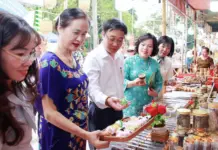The pagoda in Ha Noi, known as Ba Tam Pagoda, has become the center of attention with the addition of two new national treasures. These treasures include a pair of stone kylin statues and a red-lacquered altar trimmed with gold. It is hoped that these valuable artifacts will help boost tourism in the area and turn the pagoda into a top destination for visitors to the capital city.
Legend has it that Ba Tam Pagoda was built during the Ly Dynasty (1009-1225) to pay tribute to the Buddha and Empress Mother Linh Nhan, also known as Y Lan. Y Lan was a notable figure during the Ly Dynasty, famous for her intelligence, beauty, and gentle attitude. She was the concubine of King Ly Thanh Tong and the mother of King Ly Nhan Tong. Y Lan played a significant role in ruling the country and promoting Buddhism.
Ba Tam Pagoda suffered damage over the years, but in 2018, it underwent a comprehensive repair and embellishment project funded by the district and villagers. The pagoda’s collection of precious artifacts, including the two recently recognized national treasures, make it a remarkable site. The pair of stone kylin statues date back to the 12th century and are considered masterpieces of Vietnamese art. The red-lacquered altar, which boasts high architectural and sculptural values, dates back to the 16th century.
Furthermore, the pagoda possesses various ancient artifacts from the Ly Dynasty, such as stones, pottery pieces, stone crocodile statues, and a well. Additionally, there are four stone steles from the later Le Dynasty and Nguyen Dynasty, recording the renovations of the pagoda during these periods.
Archaeological excavations conducted in recent years have confirmed the significant cultural and historical values of Ba Tam Pagoda, providing insight into its architectural structure and the influence of Empress Y Lan on Vietnamese spiritual life.
The pagoda has long been a popular destination for locals seeking relaxation and tranquility. It is particularly busy on the first day of each lunar month and during the Ba Tam Pagoda festival, held from the 19th to the 21st day of the second lunar month. The festival attracts visitors not only from Gia Lam District but also from nearby provinces.
Given its location and rich cultural and historical heritage, Ba Tam Pagoda has great potential to become a spiritual tourism destination. The local authorities, together with travel agencies, are working on developing specific tours and routes that connect the pagoda with other nearby relics and craft villages, enhancing the overall visitor experience. The district also plans to promote the new national treasures to preserve and showcase them in Vietnamese spiritual and cultural life.
In addition to its cultural attractions, Gia Lam District also boasts craft villages with great tourism potential, including Bat Trang and Kim Lan pottery villages. Through these initiatives, the district aims to enrich spiritual and cultural tourism and create a comprehensive experience for tourists.
Efforts are also being made to preserve and promote other historic sites in the region. Phu Tho Province has announced a planning project to preserve and enhance the value of the Hung Kings temple relic site. The project aims to safeguard the natural landscapes and ecological environment of the site while turning it into an educational and attractive tourist destination that celebrates the country’s history and heritage.
Overall, Ba Tam Pagoda and the surrounding region have great potential to become a prominent cultural and spiritual tourism destination, attracting visitors with its rich history, valuable artifacts, and tranquil atmosphere.



